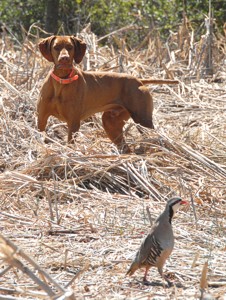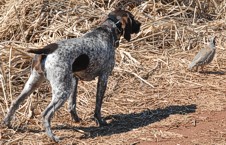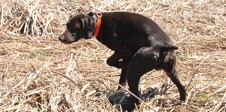|
|

|
|
Sight Pointing So, sight pointing is still a good thing, in that it's better for the dog to stop in its tracks and point the visible bird than the alternative: running the bird down. But some dogs will start to ignore their noses and only really point when they have a bird in sight. That's a bad habit, and can often lead to (especially in thicker cover) pointing on birds that are literally a foot in front of the dog's nose. That proximity means that the bird is more likely to bust out before a hunter can get close enough to work, or that the pressure will be too much for the dog, and he'll just pounce on that bird that's filling his entire visual focus. Don't scold your dog because he points on sight (since visual bird encounters are going to happen), but rather do exercises that help to reinforce the more desireable longer range scent pointing. The classic maneuver is to work the dog into a situation where he comes across the bird's scent cone in a cross-wind manner. Meaning, the dog's moving ahead, with the wind coming from one side, perpendicular to his path. With the bird some yards off to his side, his forward movement will bring him across the bird's scent with plenty of room to work. Such encounters are usually blind (meaning, the dog doesn't see it coming and can't see the planted/trapped bird), and if worked correctly, will bolster the scent pointing urge, making sight pointing feel less important to the dog. Browse The EU Here: A-C | D-F | G-I | J-L | M-O | P-R | S-V | W-Z |
|
^Top | Home | About UplandLife.com | Contact Us | Advertising/Listings | Privacy / Policies | Site Map Entire contents copyright © 2024 UplandLife.com, All Rights Reserved. Content Technology From NorseCode. |


